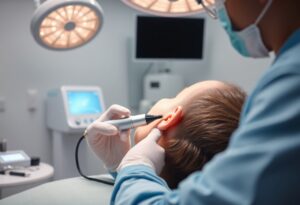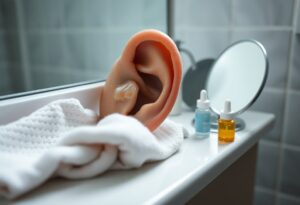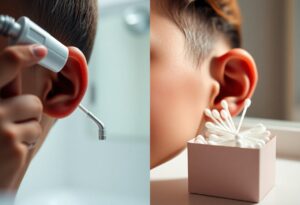Surfer’s Ear – What Is It?
Surfer’s ear affects far more people than just those who ride waves. This common condition, medically known as external auditory canal exostoses (EACE), develops when bony growths form inside the ear canal. While surfers gave this condition its name, anyone who spends regular time in cold water faces the same risk.
The condition develops slowly and silently. Many people remain unaware they have surfer’s ear until symptoms become noticeable, which can take 10 to 15 years of regular cold water exposure. At Earwax Removal Devon, we regularly see patients who have been enjoying Devon’s coastal waters for years before discovering they have developed this condition. Research from Stanford Health Care shows that men who surfed regularly for 20 years had a 50% chance of developing significant ear canal blockages.
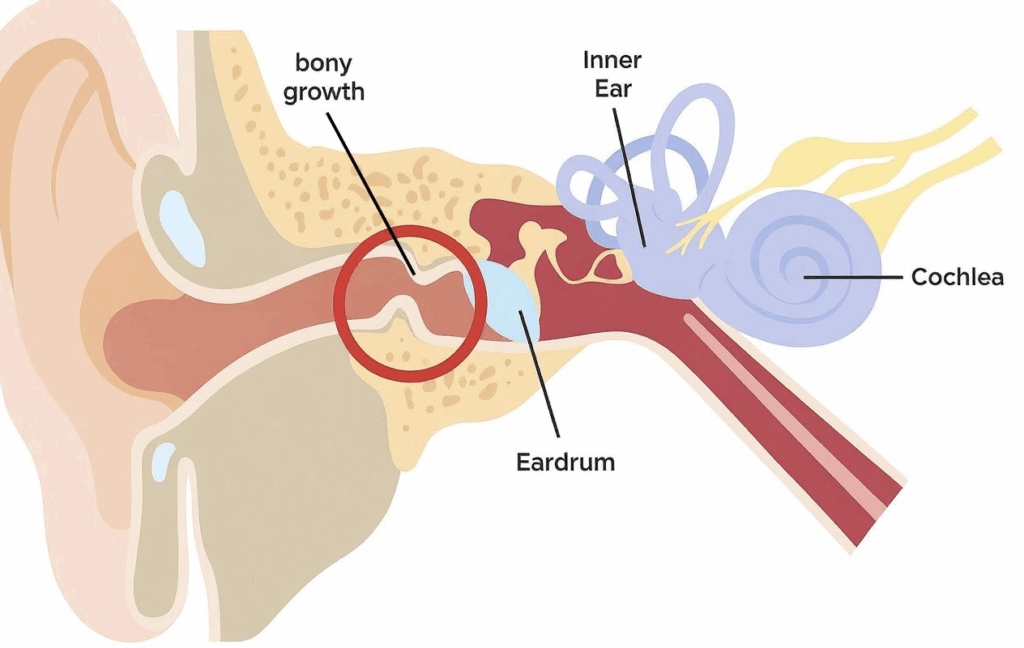
What Causes Surfer’s Ear?
Cold water triggers the development of surfer’s ear through a specific biological response. When cold water repeatedly enters the ear canal, your body attempts to protect the delicate structures inside. This protective mechanism involves warming the affected area, which activates bone-producing cells within the ear canal.
The process follows a predictable pattern. Cold water swirls along the ear canal, causing temperature fluctuations that stimulate bone growth. Over time, these bony growths, called exostoses, gradually narrow the ear canal. Water temperatures below 19 degrees Celsius pose the highest risk, which means most UK coastal waters present a constant threat year-round.
According to research published in the European Archives of Oto-Rhino-Laryngology, nearly 90% of surfers show evidence of exostosis development. The condition doesn’t discriminate based on skill level or experience – regular exposure to cold water remains the primary factor.
Who Does Surfer’s Ear Affect?
Water sports enthusiasts face the greatest risk of developing surfer’s ear. Open water swimmers, kayakers, surfers, and divers all experience regular cold water exposure that can trigger the condition. The Health Service Executive in Ireland notes that anyone regularly in cold water can develop exostoses, not just surfers.
Geographic location plays a significant role in risk levels. People living in coastal areas with consistently cold water temperatures, such as Devon’s coastline, face higher exposure risks. Even during the warmest months, average sea temperatures around the UK rarely exceed 17 degrees Celsius, keeping water sports participants in the danger zone. Our team at Earwax Removal Devon frequently treats patients from across the county who have developed surfer’s ear from regular activities in local waters, from Croyde to Salcombe.
Age and gender also influence development patterns. Studies indicate that men develop surfer’s ear more frequently than women, though researchers haven’t definitively established why this difference exists. The condition typically becomes apparent in adults who have maintained regular cold water activities for extended periods.
Recognizing the Symptoms
Early symptoms of surfer’s ear often go unnoticed. The bony growths develop gradually, creating problems only when they become large enough to interfere with normal ear function. Water getting trapped in your ear after swimming or surfing represents one of the earliest warning signs.
Recurrent ear infections become increasingly common as the condition progresses. The narrowed ear canal creates ideal conditions for bacteria to multiply, leading to repeated infections that may seem unrelated to water activities. These infections often prove difficult to treat completely without addressing the underlying structural changes.
Hearing loss develops as the bony growths continue expanding. The narrowed ear canal reduces sound transmission, creating a gradual decline in hearing ability. Some people describe feeling like their ears are constantly blocked or plugged, even when no water is present. Many patients visiting Earwax Removal Devon initially believe their hearing problems stem from earwax buildup, only to discover the underlying structural changes caused by surfer’s ear.
Without proper treatment, severe cases can result in complete ear canal closure. This extreme outcome leads to significant hearing loss and creates ongoing management challenges that require surgical intervention.
Prevention Strategies
Preventing surfer’s ear requires consistent protection during cold water activities. Wearing properly fitted earplugs provides the most effective defense against temperature-related ear canal changes. Silicone earplugs designed specifically for water sports offer superior protection compared to standard foam varieties.
Neoprene hoods add another layer of protection, particularly for surfers and divers who spend extended periods in cold water. These hoods help maintain ear canal temperature while providing additional protection against wind and water exposure.
Local sports shops can provide guidance on selecting appropriate ear protection for specific water activities. The investment in quality protective equipment proves minimal compared to the long-term consequences of untreated surfer’s ear.
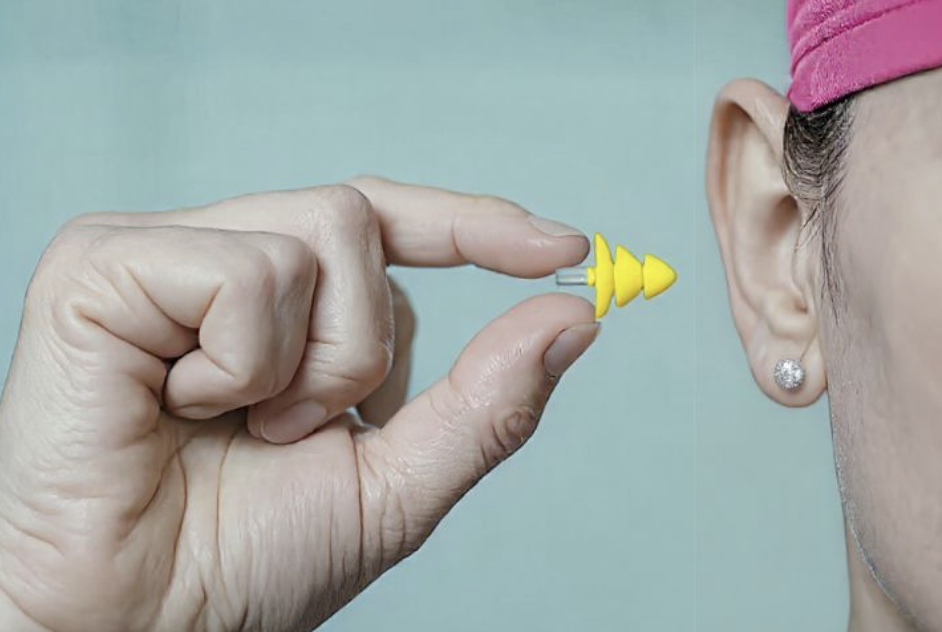
When Is Surgical Intervention Needed?
Surgery becomes necessary when conservative treatments fail to manage symptoms effectively. Severe cases with significant ear canal narrowing require surgical removal of the bony growths to restore normal ear function.
The surgical procedure, called canalplasty, involves removing excess bone using specialized techniques. Modern approaches include micro-chisel methods that offer less invasive alternatives to traditional drilling techniques. These advanced procedures reduce recovery time while maintaining excellent outcomes.
Surgeons typically perform the procedure under general anesthesia, accessing the ear canal directly or through an incision behind the ear. The choice of approach depends on the size and location of the bony growths. Post-surgical care requires avoiding water exposure for at least eight weeks to ensure proper healing.
How Earwax Removal with Microsuction Can Help
Microsuction plays a valuable role in managing surfer’s ear complications, particularly when earwax becomes trapped behind the bony growths. The narrowed ear canal created by exostoses makes natural wax migration difficult, leading to impaction and associated problems.
Research published in the British Journal of General Practice demonstrates that microsuction achieves a 91% success rate in earwax removal. This technique uses gentle suction to remove wax buildup without introducing water into the ear canal, making it ideal for people with surfer’s ear.
At Earwax Removal Devon, we see surfer’s ear patients regularly who benefit significantly from professional microsuction services. The procedure offers several advantages over traditional ear irrigation methods. Microsuction doesn’t require water, eliminating the risk of trapped moisture that could worsen existing problems. The technique provides excellent visualization throughout the process, allowing practitioners to work safely around the bony growths characteristic of surfer’s ear.
Professional microsuction services can help maintain ear health while managing the ongoing challenges created by exostoses. Regular professional cleaning prevents wax buildup that could compound hearing difficulties or increase infection risks. Our experienced team at Earwax Removal Devon understands the unique challenges faced by surfer’s ear patients and provides specialized care tailored to their specific needs.
Microsuction proves particularly beneficial for surfer’s ear patients because it addresses the mechanical problems created by the narrowed ear canal. The technique can safely remove accumulated debris, dead skin cells, and earwax that become trapped behind the bony growths, providing immediate relief from blocked sensations and improving hearing clarity.
The gentle nature of microsuction makes it suitable for regular maintenance, helping surfer’s ear patients maintain optimal ear health between medical appointments. This ongoing care approach helps prevent complications while preserving remaining ear canal function. At Earwax Removal Devon, we work closely with surfer’s ear patients to develop personalized maintenance schedules that keep their ears healthy and comfortable, allowing them to continue enjoying Devon’s beautiful coastal waters safely.



